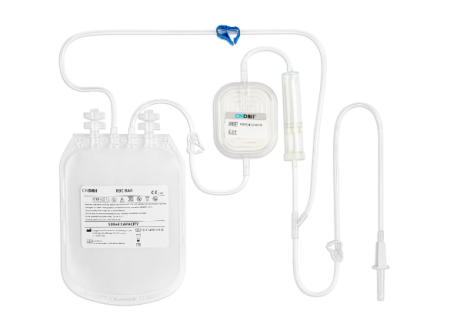Leukoreduction — the removal of white blood cells (leukocytes) from blood components prior to transfusion — is a cornerstone of modern transfusion safety. While the clinical necessity for leukoreduction is well established, the efficiency and consistency of this process are heavily influenced by the design of the leukoreduction filter itself.
As global standards in transfusion medicine evolve and adverse outcomes become less acceptable, understanding the engineering principles behind these filters has never been more critical. This article explores how filter design affects leukoreduction performance, the key mechanisms involved, and the implications for patient safety and healthcare systems.
Leukocytes, although essential for immune defense, pose significant risks when present in transfused blood products. These include:
· Febrile non-hemolytic transfusion reactions (FNHTRs)
· HLA alloimmunization, which can impair future transfusions and transplants
· Transmission of latent viruses, particularly cytomegalovirus (CMV)
· Transfusion-related immunomodulation (TRIM), potentially increasing infection risk in vulnerable patients
To mitigate these risks, regulatory bodies such as AABB, the European Union Blood Directives, and the World Health Organization (WHO) require that filtered blood products contain fewer than 1 × 10⁶ residual leukocytes per unit. Achieving this standard consistently depends largely on the performance of the leukoreduction filter.
Modern leukoreduction filters rely on a combination of physical and chemical interactions to selectively remove leukocytes while preserving other blood components. The main mechanisms include:
Filters use microporous structures to physically exclude leukocytes based on size differences. However, overly restrictive pore sizes may also trap red blood cells or platelets, leading to product loss.
Advanced filters are often coated with functional groups or polymers that enhance leukocyte adhesion without affecting red blood cells or platelets. This selective binding improves capture efficiency while minimizing non-specific interactions.
Optimal flow rates ensure efficient leukocyte capture without inducing shear stress that could damage RBCs or activate platelets. Too fast, and efficiency drops; too slow, and clogging or hemolysis becomes a concern.
Multi-layered or gradient-density filters allow staged filtration, reducing the likelihood of premature clogging and ensuring even distribution of leukocyte trapping across the matrix.

The ideal leukoreduction filter must balance two competing objectives:
· Maximizing leukocyte retention
· Minimizing damage or loss of red blood cells and platelets
For red blood cell units:
· Excessive mechanical stress or inappropriate surface chemistry can lead to hemolysis or loss of hemoglobin.
For platelet-rich plasma (PRP):
· Poorly designed surfaces may trigger platelet activation or aggregation, reducing therapeutic efficacy.
Clinical studies using flow cytometry-based residual leukocyte counts have shown that even minor variations in filter design can result in meaningful differences in post-filtration leukocyte levels. Therefore, precise engineering is essential to meet regulatory thresholds and ensure consistent product quality.
Recent advancements in materials science and microfluidics have led to significant improvements in filter performance. Key innovations include:
Electrospun nanofibers offer high surface-area-to-volume ratios and precise control over pore size, enabling highly selective leukocyte capture with minimal impact on RBCs and platelets.
These neutral-charge balancing coatings reduce non-specific protein adsorption, lowering the risk of platelet loss and filter clogging while maintaining biocompatibility.
Microfluidic channels or passive pressure-regulating structures help maintain optimal flow rates, improving filtration consistency without relying solely on gravity or external pumps.
In extended storage applications, antimicrobial-coated filters help preserve sterility without requiring additional antibiotics or refrigeration.
From a regulatory standpoint, leukoreduction filters must undergo rigorous testing before approval. Standard requirements include:
· Pre- and post-filtration leukocyte counts
· Hemolysis rate assessments
· Platelet yield recovery (for PRP filters)
· Pressure differential and flow rate thresholds
· Sterility and biocompatibility testing
Organizations like AABB, EU Blood Directives, and WHO emphasize the need for validated, reproducible filter performance to ensure patient safety. As such, manufacturers must prioritize not only material innovation but also manufacturing consistency, supply chain reliability, and post-market surveillance.
When selecting leukoreduction filters, healthcare providers should consider the following factors:
Factor | Description |
Compatibility | Must fit existing blood collection systems (e.g., top/bottom bag configurations, in-line filtration) |
Filtration Time | Faster processing reduces staff workload and turnaround time |
Efficiency Across Products | Should perform consistently for red blood cells, platelets, and plasma |
Storage Conditions | Shelf life and temperature sensitivity affect usability and inventory planning |
Post-Filtration Quality | Maintain ATP levels, pH stability, and cellular viability |
With the rise of personalized medicine and the increased use of irradiated and pathogen-reduced blood products, filters must adapt to more complex workflows where leukoreduction is just one step in a multi-stage process.
Looking ahead, several promising developments are shaping the next generation of leukoreduction filters:
· AI-assisted fluid dynamics modeling for optimized filter geometry
· Sustainable biomaterials to reduce medical waste and environmental impact
· Real-time monitoring systems that provide feedback on filtration efficiency during use
· Customizable filters tailored for neonatal, oncology, or transplant-specific needs
As demand for safe and effective blood products increases—especially in aging populations and resource-limited settings—the importance of precision-engineered leukoreduction filters will only grow.
Leukoreduction filter design is not merely a technical detail—it is a vital component of modern transfusion safety. From pore structure to surface chemistry, every aspect of filter engineering impacts clinical outcomes. As transfusion practices become more advanced and patient expectations rise, the role of high-performance, reliable leukoreduction technology will remain central to blood banking and patient care.
In this evolving landscape, companies like DaJiMed are at the forefront of innovation, delivering advanced filtration solutions that meet the highest standards of safety, efficiency, and clinical reliability.
Copyright © Guangzhou DaJi Medical Science and Technology Co., Ltd. All Rights Reserved Sitemap | Powered by 